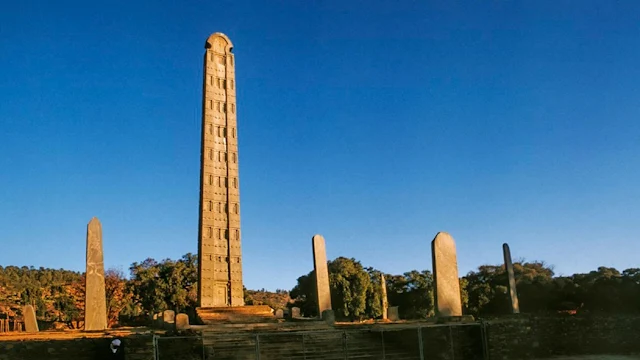Axum: The Echoes of an Ancient Empire
A Glimpse into Ethiopia's Glorious Past
Axum, a once-mighty kingdom, is a testament to Ethiopia's rich and
ancient history. This ancient city, located in the northern highlands of
Ethiopia, was the heart of a powerful empire that flourished between the 1st
and 10th centuries AD.
The Rise of an Empire
The Axumite Kingdom reached its zenith around the 4th century AD. During
this period, it was one of the most powerful states in the region, trading with
Rome, Byzantium, and India. The kingdom's strategic location on the Red Sea
coast allowed it to control vital trade routes, bringing immense wealth and
power.
The Legacy of Axum
Axum's legacy is still visible today in its impressive archaeological
sites. Some of the most notable include:
- Stelae: These towering monolithic obelisks are a unique
feature of Axumite architecture. The largest stele, known as the Great
Stele of Axum, once stood at over 33 meters tall.
- Royal
Tombs:
The royal tombs of Axum are a testament to the wealth and power of the
Axumite kings. These underground tombs are adorned with intricate carvings
and inscriptions.
- Ancient
Churches:
The ancient churches of Axum, such as St. Mary of Zion, are some of the
oldest Christian churches in the world.
A visit to Axum is a journey back in time. Visitors can explore the
ancient city's ruins, marvel at its towering stelae, and experience the rich
cultural heritage of Ethiopia. The city's serene atmosphere and breathtaking
landscapes offer a truly unforgettable experience.
Axum: The Echoes of an Ancient Empire
The Kingdom of Axum, a marvel of ancient civilization, stands as a
testament to the ingenuity, cultural richness, and strategic influence of its
people. Situated in present-day Ethiopia and Eritrea, Axum flourished between
the 1st and 7th centuries CE, commanding respect as a powerhouse in trade,
religion, and innovation. Today, its enduring legacy offers a captivating window
into a bygone era of African prominence.
Foundations of a Mighty Kingdom
Axum’s ascent as a dominant empire began around the 1st century CE, when
it became a central hub for trade routes connecting the Roman Empire, India,
and Arabia. Its capital, Axum, was a bustling metropolis where merchants
exchanged goods such as ivory, gold, spices, and textiles. This trade brought
immense wealth, enabling Axum to assert its influence over vast territories,
including parts of modern-day Sudan, Yemen, and the Arabian Peninsula.
A Cultural and Religious Crossroads
Axum's significance transcended its economic might. It became a cultural
melting pot where diverse traditions converged. The introduction of
Christianity in the 4th century CE, under King Ezana’s rule, marked a pivotal
moment. As one of the first nations to adopt Christianity officially, Axum
forged a unique identity that blended its indigenous traditions with the new
faith. Today, the Ethiopian Orthodox Church traces its roots to this
transformative era.
Architectural Marvels: The Stelae of
Axum
Axum’s stelae—towering obelisks carved from single granite blocks—remain
among the most iconic remnants of the kingdom. These structures, some exceeding
30 meters in height, were erected as funerary monuments to honor rulers and
elites. Their intricate carvings, featuring door and window motifs, hint at the
sophistication of Axumite architecture and engineering. The Great Stele, once
the tallest, stands as a symbol of the empire’s grandeur, even in its fallen
state.
Innovations in Coinage and Script
Axum was among the earliest African civilizations to mint its own
currency, a move that solidified its role in international commerce. The coins,
inscribed in Greek and Ge’ez (the indigenous script), bore symbols reflecting
the kingdom's Christian faith and royal authority. This monetary system
facilitated trade and served as a medium to propagate Axum’s religious and
political ideals.
Decline and Enduring Legacy
By the 7th century CE, Axum faced challenges from shifting trade routes
and emerging Islamic powers, which diminished its economic and political
influence. Despite its decline, the cultural and religious imprints of the
Axumite Empire remain deeply woven into the fabric of Ethiopia. The ancient
city of Axum, now a UNESCO World Heritage Site, continues to draw scholars,
pilgrims, and tourists eager to explore its storied past.
The Kingdom of Axum exemplifies the richness of Africa’s historical
narrative, challenging stereotypes of the continent as lacking advanced
civilizations. Its contributions to trade, religion, and innovation resonate
through time, reminding us of a world where Axum stood as a beacon of power and
culture. The echoes of its ancient empire not only inspire pride but also offer
valuable insights into the interconnectedness of human history.
The Decline of Axum
The decline of the Axumite Kingdom began in the 10th century AD. A
combination of factors, including internal strife, external invasions, and
economic decline, led to the kingdom's eventual downfall. However, Axum's
cultural and historical legacy continues to inspire and fascinate people around
the world.



